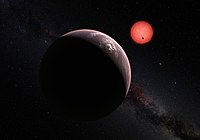TRAPPIST-1b
| Atmosphere | |
|---|---|
| Composition by volume | None or extremely thin[6][7] |
TRAPPIST-1b, also designated as 2MASS J23062928-0502285 b, is a mainly rocky exoplanet orbiting around the ultra-cool dwarf star TRAPPIST-1, located 40.7 light-years (12.5 parsecs) away from Earth in the constellation of Aquarius. The planet was detected using the transit method, where a planet dims the host star's light as it passes in front of it. It was first announced on May 2, 2016,[1] and later studies were able to refine its physical parameters.
The planet is about 37% more massive than Earth and about 39% larger in volume; thus its density is very similar. It is the innermost of seven planets orbiting TRAPPIST-1, all of which are terrestrial, but is too close to its star to be in the habitable zone. Observations by the James Webb Space Telescope announced in 2023 suggest that it does not have any significant atmosphere.[6][7] Its albedo is very low, making it dark in color.
Physical characteristics
Mass, radius, and temperature
TRAPPIST-1b is very similar in both mass, radius, and gravity to Earth. It has a radius of 1.116 R🜨, a mass of 1.374 M🜨, and about 110% Earth's surface gravity.[2] Initial estimates of the planet's density suggested that it is not entirely rocky; with a density of 3.98 g/cm3, about ≤5% of its mass must be volatiles, likely in the form of a thick Venus-like atmosphere due to it receiving nearly four times more energy than Earth does.[3] However, refined density estimates show that the planet is only slightly less dense than Earth.[2]
Assuming the presence of an atmosphere, the planet's surface temperature was initially estimated to be between 750 K (477 °C; 890 °F) and 1,500 K (1,230 °C; 2,240 °F), potentially as high as 2,000 K (1,730 °C; 3,140 °F). This is much hotter than the surface of Venus and may be hot enough that the surface is molten lava.[3] An observation of the secondary eclipse of TRAPPIST-1b by the James Webb Space Telescope, announced in 2023, suggests that the planet does not have any significant atmosphere, with a measured surface temperature of about 503 K (230 °C; 446 °F),[6][7] and a low albedo.[8] The planet may be very geologically active due to tidal squeezing similar to Jupiter's moon Io, which happens to have a similar orbital period and eccentricity (see TRAPPIST-1#Resonance and tides for references).
Orbit
TRAPPIST-1b orbits very close to its parent star. One orbit requires only 36 hours, or about 1.51 Earth days.[9] It orbits about 0.0115 AU (1.72 million km; 1.07 million mi) from its star, just 1.2% the distance between Earth and the Sun.[3] The close proximity to its host star means that TRAPPIST-1b is likely tidally locked. It also has a very circular orbit, with an eccentricity of 0.00622, significantly more circular than Earth's orbit, which has an eccentricity of 0.0167086.
Host star
TRAPPIST-1b orbits the ultracool red dwarf star TRAPPIST-1. It has a mass of 0.089 M☉ and is only 0.121 R☉, with a surface temperature of 2,511 K (2,238 °C; 4,060 °F) and an age between 3 and 8 billion years. The Sun, in comparison, has a surface temperature of 5,778 K (5,505 °C; 9,941 °F) and is about 4.5 billion years old. TRAPPIST-1 is also very dim, with a luminosity about 0.0005 times that of the Sun. It is too faint to be seen with the naked eye, having an apparent magnitude of 18.80.
Atmosphere

The combined transmission spectra of TRAPPIST-1 b and c rule out cloud-free hydrogen-dominated atmospheres for both planets, so they are unlikely to harbor extended gas envelopes. Also, no helium emission from TRAPPIST-1b has been detected.[10] Prior to JWST observations, other atmospheres, from a cloud-free water-vapor atmosphere to a Venus-like atmosphere, remained consistent with the featureless spectra.[11]
In 2018, the planet's atmosphere was better examined by the
An observation of the secondary eclipse of TRAPPIST-1b by the
Gallery
-
Artist's view of planets transiting red dwarf star in TRAPPIST-1 system[14]
-
The Sun and the ultracool dwarf star TRAPPIST-1 to scale. The faint star has only 11% of the diameter of the Sun and is much redder in colour.
-
Artist's impression of three of the planets (b, c, and d) orbiting TRAPPIST-1
-
Artist's impression video, near one of the three planets orbiting TRAPPIST-1. One of the inner planets is shown in transit across the disc of its tiny and dim parent star.
See also
- 55 Cancri e, a very hot planet with a confirmed atmosphere.
- LHS 3844 b, a hot, rocky planet without an atmosphere
References
- ^ PMID 27135924.
- ^ S2CID 222125312.
- ^ S2CID 3441829.
- S2CID 54034373.
- S2CID 220041987.
- ^ S2CID 257767242.
- ^ STScI. 27 March 2023. Retrieved 27 March 2023.
- ^ .
- ^ .
- S2CID 205249853.
- ^ Sherburne, Morgan (25 September 2023). "James Webb Space Telescope's first spectrum of a TRAPPIST-1 planet". Phys.org. Archived from the original on 29 September 2023. Retrieved 29 September 2023.
- .
- ^ "Artist's view of planets transiting red dwarf star in TRAPPIST-1 system". www.spacetelescope.org. Retrieved 21 July 2016.

![Artist's view of planets transiting red dwarf star in TRAPPIST-1 system[14]](http://upload.wikimedia.org/wikipedia/commons/thumb/5/50/Artist%27s_view_of_planets_transiting_red_dwarf_star_in_TRAPPIST-1_system.jpg/200px-Artist%27s_view_of_planets_transiting_red_dwarf_star_in_TRAPPIST-1_system.jpg)







